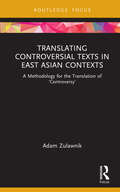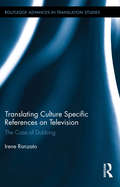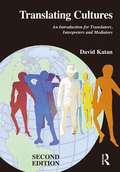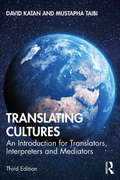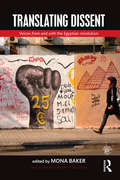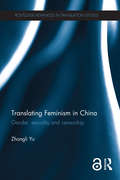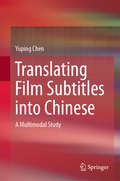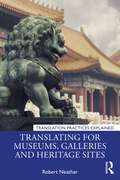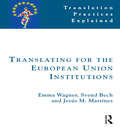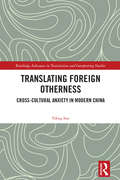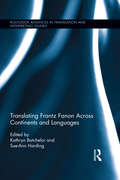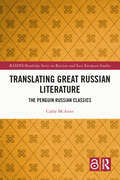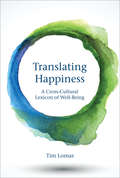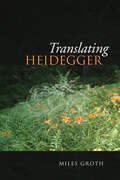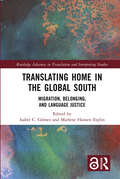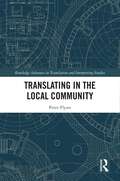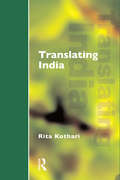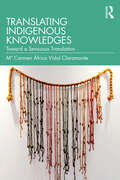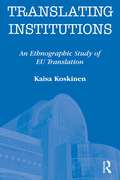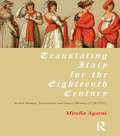- Table View
- List View
Translating Controversial Texts in East Asian Contexts: A Methodology for the Translation of ‘Controversy’ (Routledge Advances in Translation and Interpreting Studies)
by Adam ZulawnikZulawnik focuses on the broad concept of ‘controversy’ and issues pertaining to the translation of politically and historically controversial texts in East Asia. The research methodology is exemplified through a case study in the form of the author’s translation of the best-selling Japanese graphic novel (manga) Manga Kenkanryū (Hate Hallyu: The Comic) by Sharin Yamano (2005), a work that has been problematised as an attack on South Korean culture and the Korean Wave. Issues analysed and discussed in the research include translation risk, ethics, a detailed methodology for the translation of so-called controversial texts exemplified through numerous thematically divided examples from the translation of the chosen Japanese text, as well as examples from a Korean language equivalent (Manhwa Hyeomillyu – Hate Japanese Wave), and definition and contextualisation of the concept of ‘controversy’. There has been limited research in the field of translation studies, which seeks to exemplify potential pragmatic approaches for the translation of politically-charged texts, particularly in multi-modal texts such as the graphic novel. It is hoped that Zulawnik’s research will serve both as a valuable source when examining South Korea–Japan relations and a theoretical and methodological base for further research and the development of an online augmented translation space with devices specifically suited for the translation of multi-modal texts such as – but not limited to – graphic novels and visual encyclopaedias.
Translating Culture Specific References on Television: The Case of Dubbing (Routledge Advances in Translation and Interpreting Studies)
by Irene RanzatoTranslating Culture Specific References on Television provides a model for investigating the problems posed by culture specific references in translation, drawing on case studies that explore the translational norms of contemporary Italian dubbing practices. This monograph makes a distinctive contribution to the study of audiovisual translation and culture specific references in its focus on dubbing as opposed to subtitling, and on contemporary television series, rather than cinema. Irene Ranzato’s research involves detailed analysis of three TV series dubbed into Italian, drawing on a corpus of 95 hours that includes nearly 3,000 CSR translations. Ranzato proposes a new taxonomy of strategies for the translation of CSRs and explores the sociocultural, pragmatic and ideological implications of audiovisual translation for the small screen.
Translating Cultures: An Introduction for Translators, Interpreters and Mediators
by David KatanAs the 21st century gets into stride so does the call for a discipline combining culture and translation. This second edition of Translating Cultures retains its original aim of putting some rigour and coherence into these fashionable words and lays the foundation for such a discipline. This edition has not only been thoroughly revised, but it has also been expanded. In particular, a new chapter has been added which focuses specifically on training translators for translational and intercultural competencies. The core of the book provides a model for teaching culture to translators, interpreters and other mediators. It introduces the reader to current understanding about culture and aims to raise awareness of the fundamental role of culture in constructing, perceiving and translating reality. Culture is perceived throughout as a system for orienting experience, and a basic presupposition is that the organization of experience is not 'reality', but rather a simplified model and a 'distortion' which varies from culture to culture. Each culture acts as a frame within which external signs or 'reality' are interpreted. The approach is interdisciplinary, taking ideas from contemporary translation theory, anthropology, Bateson's logical typing and metamessage theories, Bandler and Grinder's NLP meta-model theory, and Hallidayan functional grammar. Authentic texts and translations are offered to illustrate the various strategies that a cultural mediator can adopt in order to make the different cultural frames he or she is mediating between more explicit.
Translating Cultures: An Introduction for Translators, Interpreters and Mediators
by David Katan Mustapha TaibiThis bestselling coursebook introduces current understanding about culture and provides a model for teaching culture to translators, interpreters and other mediators. The approach is interdisciplinary, with theory from Translation Studies and beyond, while authentic texts and translations illustrate intercultural issues and strategies adopted to overcome them. This new (third) edition has been thoroughly revised to update scholarship and examples and now includes new languages such as Arabic, Chinese, German, Japanese, Russian and Spanish, and examples from interpreting settings. This edition revisits the chapters based on recent developments in scholarship in intercultural communication, cultural mediation, translation and interpreting. It aims to achieve a more balanced representation of written and spoken communication by giving more attention to interpreting than the previous editions, especially in interactional settings. Enriched with discussion of key recent scholarly contributions, each practical example has been revisited and/ or updated. Complemented with online resources, which may be used by both teachers and students, this is the ideal resource for all students of translation and interpreting, as well as any reader interested in communication across cultural divides. Additional resources are available on the Routledge Translation Studies Portal: http://routledgetranslationstudiesportal.com/
Translating Dissent: Voices From and With the Egyptian Revolution (Critical Perspectives on Citizen Media)
by Mona Baker*Written by the winners of the Inttranews Linguists of the Year award for 2016!* Discursive and non-discursive interventions in the political arena are heavily mediated by various acts of translation that enable protest movements to connect across the globe. Focusing on the Egyptian experience since 2011, this volume brings together a unique group of activists who are able to reflect on the complexities, challenges and limitations of one or more forms of translation and its impact on their ability to interact with a variety of domestic and global audiences. Drawing on a wide range of genres and modalities, from documentary film and subtitling to oral narratives, webcomics and street art, the 18 essays reveal the dynamics and complexities of translation in protest movements across the world. Each unique contribution demonstrates some aspect of the interdependence of these movements and their inevitable reliance on translation to create networks of solidarity. The volume is framed by a substantial introduction by Mona Baker and includes an interview with Egyptian activist and film-maker, Philip Rizk. With contributions by scholars and artists, professionals and activists directly involved in the Egyptian revolution and other movements, Translating Dissent will be of interest to students of translation, intercultural studies and sociology, as well as the reader interested in the study of social and political movements. Online materials, including links to relevant websites and videos, are available at http://www.routledge.com/cw/baker. Additional resources for Translation and Interpreting Studies are available on the Routledge Translation Studies Portal: http://cw.routledge.com/textbooks/translationstudies.
Translating Feminism: Interdisciplinary Approaches to Text, Place and Agency (Palgrave Studies in Language, Gender and Sexuality)
by Maud Anne Bracke Julia C. Bullock Penelope Morris Kristina SchulzThis edited book addresses the diversity across time and space of the sites, actors and practices of feminist translation from 1945-2000. The contributors examine what happens when a politically motivated text is translated linguistically and culturally, the translators and their aims, and the strategies employed when adapting texts to locally resonating discourses. The collection aims to answer these questions through case studies and a conceptual rethinking of the process of politically engaged translation, considering not only trained translators and publishers, but also feminist activists and groups, NGOs and writers. The book will be of interest to students and researchers in the fields of translation studies, gender/women's studies, literature and feminist history.
Translating Feminism in China: Gender, Sexuality and Censorship (Routledge Advances in Translation and Interpreting Studies)
by Zhongli YuThis book explores translation of feminism in China through examining several Chinese translations of two typical feminist works: The Second Sex (TSS, Beauvoir 1949/1952) and The Vagina Monologues (TVM, Ensler 1998). TSS exposes the cultural construction of woman while TVM reveals the pervasiveness of sexual oppression toward women. The female body and female sexuality (including lesbian sexuality) constitute a challenge to the Chinese translators due to cultural differences and sexuality still being a sensitive topic in China. This book investigates from gender and feminist perspectives, how TSS and TVM have been translated and received in China, with special attention to how the translators meet the challenges. Since translation is the gateway to the reception of feminism, an examination of the translations should reveal the response to feminism of the translator as the first reader and gatekeeper, and how feminism is translated both ideologically and technically in China. The translators’ decisions are discussed within the social, historical, and political contexts. Translating Feminism in China discusses, among other issues: Feminist Translation: Practice, Theory, and Studies Translating the Female Body and Sexuality Translating Lesbianism Censorship, Sexuality, and Translation This book will be relevant to postgraduate students and researchers of translation studies. It will also interest academics interested in feminism, gender studies and Chinese literature and culture. Zhongli Yu is Assistant Professor of Translation Studies at the University of Nottingham Ningbo China (UNNC).
Translating Film Subtitles into Chinese: A Multimodal Study
by Yuping ChenThis book examines three metafunction meanings in subtitle translation with three research foci, i.e., the main types of cross-modal interrelation, the primary function of semiotic interplay, and the key linguistic components influencing the subtitles. It goes beyond traditional textual analysis in translation studies; approaches subtitle translation from a multimodality standpoint; and breaks through the linguistic restraints on subtitling research by underscoring the role of semiotic interplay. In the field of multimodality, this book bridges subtitling and multimodality by investigating the interweaving relationships between different semiotic modes, and their corresponding impacts on subtitle translation.
Translating for Museums, Galleries and Heritage Sites (Translation Practices Explained)
by Robert NeatherIn any museum, gallery, or heritage site that wishes to engage with foreign-language visitors, translation is essential. Providing texts in foreign languages – whether for international visitors from different language cultures or for heritage speakers of local minority languages – is centrally important in enabling these visitors to make sense of what they see displayed. Yet despite this awareness, and a growing body of research in the field, there has hitherto been little available in the way of practical training in this area of translation. This book aims to help fill that need.Translating for Museums, Galleries and Heritage Sites focuses on the translation of interpretive and information texts, particularly in the museum context. After an initial introduction and an overview of key concepts in both museums and translation, it looks at three broad groupings of texts from the museum text system: fixed labels and wall panels, leaflets and other portable learning resources, and catalogues and guides, including a section on websites. It concludes with a call to place translation centre stage in museum, gallery, and heritage practice. The book will be of use as a coursebook for students at both undergraduate and postgraduate levels, and for practitioners in the sector, and is designed to be suitable for both individual and class-based learning.
Translating for the European Union (Translation Practices Explained)
by Emma Wagner Svend Bech Jesús M. MartínezThe institutions of the European Union employ hundreds of translators. Why? What do they do? What sort of translation problems do they have to tackle? Has the language policy of the European Union been affected by the recent inclusion of new Member States? This book answers all those questions. Written by three experienced translators from the European Commission, it aims to help general readers, translation students and freelance translators to understand the European Union institutions and their work. Although it deals with written rather than spoken translation, much of the information it gives will be of interest to interpreters too. This second edition has been updated to reflect the new composition of the EU and changes to recruitment procedures.
Translating for the European Union Institutions (Translation Practices Explained)
by Emma Wagner Svend Bech Jesús M. MartínezThe institutions of the European Union employ hundreds of translators. Why? What do they do? What sort of translation problems do they have to tackle? Has the language policy of the European Union been affected by the recent inclusion of new Member States? This book answers all those questions. Written by three experienced translators from the European Commission, it aims to help general readers, translation students and freelance translators to understand the European Union institutions and their work. Although it deals with written rather than spoken translation, much of the information it gives will be of interest to interpreters too. This second edition has been updated to reflect the new composition of the EU and changes to recruitment procedures.
Translating Foreign Otherness: Cross-Cultural Anxiety in Modern China (Routledge Advances in Translation and Interpreting Studies)
by Yifeng SunThis book explores the deep-rooted anxiety about foreign otherness manifest through translation in modern China in its endeavours to engage in cross-cultural exchanges. It offers to theorize and contextualize a related range of issues concerning translation practice in response to foreign otherness. The book also introduces new vistas to some of the under-explored aspects of translation practice concerning ideology and cultural politics from the late Qing dynasty to the present day. Largely as a result of translation, ethnocentric beliefs and feelings have given way to a more open and liberal way to approach and appropriate foreign otherness. However, the fear of Westernization, seen as a threat to Chinese cultural integrity and social stability, is still shown sporadically through the state’s ideological control over translation. The book interprets, questions and reformulates a number of the key theoretical issues in Translation Studies and also demonstrates their ramifications in a bid to shed light on Chinese translation practice.
Translating Frantz Fanon Across Continents and Languages: Frantz Fanon Across Continents and Languages (Routledge Advances in Translation and Interpreting Studies)
by Sue-Ann Harding Kathryn BatchelorThis book provides an innovative look at the reception of Frantz Fanon’s texts, investigating how, when, where and why these—especially his seminal Les Damnés de la Terre (1961) —were first translated and read. Building on renewed interest in the author’s works in both postcolonial studies and revolutionary movements in recent years, as well as travelling theory, micro-history and histoire croisée interests in Translation Studies, the volume tells the stories of translations of Fanon’s texts into twelve different languages – Arabic, Danish, English, German, Italian, Norwegian, Persian, Polish, Russian, Serbo-Croatian, Swahili and Swedish – bringing both a historical and multilingual perspective to the ways in which Fanon is cited today. With contributions from an international, interdisciplinary group of scholars, the stories told combine themes of movement and place, personal networks and agency, politics and activism, archival research and textual analysis, creating a book that is a fresh and comprehensive volume on the translated works of Frantz Fanon and essential reading for scholars in translation studies, postcolonial studies, cultural studies, critical race studies, and African and African diaspora literature.
Translating Great Russian Literature: The Penguin Russian Classics (BASEES/Routledge Series on Russian and East European Studies)
by Cathy McAteerLaunched in 1950, Penguin’s Russian Classics quickly progressed to include translations of many great works of Russian literature and the series came to be regarded by readers, both academic and general, as the de facto provider of classic Russian literature in English translation, the legacy of which reputation resonates right up to the present day. Through an analysis of the individuals involved, their agendas, and their socio-cultural context, this book, based on extensive original research, examines how Penguin’s decisions and practices when translating and publishing the series played a significant role in deciding how Russian literature would be produced and marketed in English translation. As such the book represents a major contribution to Translation Studies, to the study of Russian literature, to book history and to the history of publishing.
Translating Great Russian Literature: The Penguin Russian Classics (ISSN)
by Cathy McAteerLaunched in 1950, Penguin’s Russian Classics quickly progressed to include translations of many great works of Russian literature and the series came to be regarded by readers, both academic and general, as the de facto provider of classic Russian literature in English translation, the legacy of which reputation resonates right up to the present day. Through an analysis of the individuals involved, their agendas, and their socio-cultural context, this book, based on extensive original research, examines how Penguin’s decisions and practices when translating and publishing the series played a significant role in deciding how Russian literature would be produced and marketed in English translation. As such the book represents a major contribution to Translation Studies, to the study of Russian literature, to book history and to the history of publishing.
Translating Happiness: A Cross-Cultural Lexicon of Well-Being (The\mit Press Ser.)
by Tim LomasHow embracing untranslatable terms for well-being—from the Finnish sisu to the Yiddish mensch—can enrich our emotional understanding and experience.Western psychology is rooted in the philosophies and epistemologies of Western culture. But what of concepts and insights from outside this frame of reference? Certain terms not easily translatable into English—for example, nirvāṇa (from Sanskrit), or agápē (from Classical Greek), or turangawaewae (from Māori)—are rich with meaning but largely unavailable to English-speaking students and seekers of wellbeing. In this book, Tim Lomas argues that engaging with “untranslatable” terms related to well-being can enrich not only our understanding but also our experience. We can use these words, Lomas suggests, to understand and express feelings and experiences that were previously inexpressible.Lomas examines 400 words from 80 languages, arranges them thematically, and develops a theoretical framework that highlights the varied dimensions of well-being and traces the connections between them. He identifies three basic dimensions of well-being—feelings, relationships, and personal development—and then explores each in turn through untranslatable words. Ânanda, for example, usually translated as bliss, can have spiritual associations in Buddhist and Hindu contexts; kefi in Greek expresses an intense emotional state—often made more intense by alcohol. The Japanese concept of koi no yokan means a premonition or presentiment of love, capturing the elusive and vertiginous feeling of being about to fall for someone, imbued with melancholy and uncertainty; the Yiddish term mensch has been borrowed from its Judaic and religious connotations to describe an all-around good human being; and Finnish offers sisu—inner determination in the face of adversity.Expanding the lexicon of well-being in this way showcases the richness of cultural diversity while reminding us powerfully of our common humanity. Lomas's website, www.drtimlomas.com/lexicography, allows interested readers to contribute their own words and interpretations.
Translating Heidegger
by Miles GrothDespite Martin Heidegger’s influence on twentieth-century philosophy, understanding his way of thinking is difficult if one relies solely on the English translations of his work. Since Gilbert Ryle misjudged his work in a 1929 review of Sein und Zeit, Heidegger’s philosophy has remained an enigma to many scholars who cannot read the original German texts. In Translating Heidegger, Groth points to mistranslations as the root cause of misunderstanding Heidegger. Translators have not achieved clarity regarding Heidegger’s fundamental words, an understanding of which is crucial to gaining access to his thought. Having been mistranslated from the ancient Greek into Latin and then into modern European languages, Heidegger’s philosophies have largely been obscured for two millennia. In this unique study, Groth examines the history of the first English translations of Heidegger’s works and reveals the elements of Heidegger’s philosophy of translation, showing it at work in Heidegger’s radical translation of Parmenides, Fragment VI.
Translating Home in the Global South: Migration, Belonging, and Language Justice (Routledge Advances in Translation and Interpreting Studies)
by Isabel C. Gómez Marlene Hansen EsplinThis collection explores the relationships between acts of translation and the movement of peoples across linguistic, cultural, and physical borders, centering the voices of migrant writers and translators in literatures and language cultures of the Global South. To offer a counterpoint to existing scholarship, this book examines translation practices as forms of both home-building and un-homing for communities in migration. Drawing on scholarship from translation studies as well as eco-criticism, decolonial thought, and gender studies, the book’s three parts critically reflect on different dimensions of the intersection of translation and migration in a diverse range of literary genres and media. Part I looks at self-translation, collaboration, and cocreation as modes of expression born out of displacement and exile. Part II considers radical strategies of literary translation and the threats and opportunities they bring in situations of detention and border policing. Part III looks ahead to the ways in which translation can act as a powerful means of fostering responsibility, solidarity, and community in building an inclusive, multilingual public sphere even in the face of climate crisis. This dynamic volume will be of particular interest to students and scholars in translation studies, migration and mobility studies, postcolonial studies, and comparative literature.
Translating Home in the Global South: Migration, Belonging, and Language Justice (ISSN)
by Isabel C. Gómez Marlene Hansen EsplinThis collection explores the relationships between acts of translation and the movement of peoples across linguistic, cultural, and physical borders, centering the voices of migrant writers and translators in literatures and language cultures of the Global South.To offer a counterpoint to existing scholarship, this book examines translation practices as forms of both home-building and un-homing for communities in migration. Drawing on scholarship from translation studies as well as eco-criticism, decolonial thought, and gender studies, the book’s three parts critically reflect on different dimensions of the intersection of translation and migration in a diverse range of literary genres and media. Part I looks at self-translation, collaboration, and cocreation as modes of expression born out of displacement and exile. Part II considers radical strategies of literary translation and the threats and opportunities they bring in situations of detention and border policing. Part III looks ahead to the ways in which translation can act as a powerful means of fostering responsibility, solidarity, and community in building an inclusive, multilingual public sphere even in the face of climate crisis.This dynamic volume will be of particular interest to students and scholars in translation studies, migration and mobility studies, postcolonial studies, and comparative literature.
Translating in the Local Community (Routledge Advances in Translation and Interpreting Studies)
by Peter FlynnThis volume showcases different forms of natural and non-professional translation and interpreting at work at multilingual sites in a single city, shedding new light on our understanding of the intersection of city, migration and translation. Flynn builds on work in translation studies, sociolinguistics, linguistic ethnography and anthropology to offer a translational perspective on scholarship on multilingualism and translation, focusing on examples from the superdiverse city of Ghent in Belgium. Each chapter comprises a different multilingual site, ranging from schools to eateries to public transport, and unpacks specific dimensions of translation practices within and against constantly shifting multilingual settings. The book also reflects on socio-political factors and methodological considerations of concern when undertaking such an approach. Taken together, the chapters seek to provide a composite picture of translation in a multilingual city, demonstrating how tracing physical, linguistic and social trajectories of movement in these contexts can deepen our understanding of the contemporary dynamics of multilingualism and natural translation and of translanguaging, more broadly. This book will be of interest to students and scholars in translation and interpreting studies, sociolinguistics, multilingualism, linguistic anthropology and migration studies.
Translating India
by Rita KothariThe cultural universe of urban, English-speaking middle class in India shows signs of growing inclusiveness as far as English is concerned. This phenomenon manifests itself in increasing forms of bilingualism (combination of English and one Indian language) in everyday forms of speech - advertisement jingles, bilingual movies, signboards, and of course conversations. It is also evident in the startling prominence of Indian Writing in English and somewhat less visibly, but steadily rising, activity of English translation from Indian languages. Since the eighties this has led to a frenetic activity around English translation in India's academic and literary circles. Kothari makes this very current phenomenon her chief concern in Translating India. The study covers aspects such as the production, reception and marketability of English translation. Through an unusually multi-disciplinary approach, this study situates English translation in India amidst local and global debates on translation, representation and authenticity. The case of Gujarati - a case study of a relatively marginalized language - is a unique addition that demonstrates the micro-issues involved in translation and the politics of language. Rita Kothari teaches English at St. Xavier's College, Ahmedabad (Gujarat), where she runs a translation research centre on behalf of Katha. She has published widely on literary sociology, postcolonialism and translation issues. Kothari is one of the leading translators from Gujarat. Her first book (a collaboration with Suguna Ramanathan) was on English translation of Gujarati poetry (Modern Gujarati Poetry: A Selection, Sahitya Akademi, New Delhi, 1998). Her English translation of the path-breaking Gujarati Dalit novel Angaliyat is in press (The Stepchild, Oxford University Press). She is currently working on an English translation of Gujarati short stories by women of Gujarat, a study of the nineteenth-century narratives of Gujarat, and is also engaged in a project on the Sindhi identity in India.
Translating Indigenous Knowledges: Toward a Sensuous Translation
by Mª Carmen Vidal ClaramonteIn this book, Vidal presents a new way of translating indigenous epistemologies. For centuries, the Western world has ordained what knowledge is and what it should be and has also been responsible for transmitting that knowledge. This "universal" knowledge has traveled to the four corners of the globe.In recent decades, there has been a steadily growing interest in dialogical epistemologies. Disciplines ranging from historiography and philosophy to anthropology are calling for this universalist idea of knowledge to be modified. Thanks to this change of perspective, other forms of knowledge, which until now have been ignored, are gradually coming to light. Indigenous knowledges are not constructed with the scientific, binary, static, Cartesian, or univocal logic characteristic of Western societies. Non-Western types of knowledge incorporate senses, emotions, body, objects, and matter. It is impossible to reduce indigenous knowledges to Western conceptualizations. The types of translation covered in this book assume that knowledge is not transmitted only in the Western way and that there are world views that take into account the emotions and body, as well as the intellect. This includes all types of beings: human, non-human, and extrahuman. In the face of this plurality of epistemologies, this book affirms that the static Western conceptual traditions characterized by a binary logic are not useful and that there is a need to translate outside the scope of these traditions.The examples given in this book show that translation is not only a process involving Western and non-Western languages. Translation is not a mere substitution of one word for another because knowledge is not only transmitted through words. It also involves non-verbal elements. Knowledge is transmitted through objects, songs, sensations, and emotions, as well as through words. Moreover, many non-Western traditions do not translate with language systems but rather with other semiotic systems, such as knots, threads, colors, and bodies in movement. This is a timely, topical, and transdisciplinary reading, of interest to advanced students and researchers in translation studies, anthropology, and beyond.
Translating Institutions: An Ethnographic Study of EU Translation
by Kaisa KoskinenTranslating Institutions outlines a framework for research on translation in institutional settings, using the Finnish translation unit at the European Commission as a case study. Because of their foundational multilingualism, the institutions of the European Union could be described as both translating and translated institutions. The European Commission alone employs nearly two thousand translators, and it is translators who draft the vast majority of outgoing EU messages. Translating Institutions sets out to explore the organizational role and professional identity of this group of cultural mediators, a group that has remained relatively invisible despite its size and central institutional role, and to use the analysis of this data to elaborate broader methodological and theoretical issues. Translating Institutions adopts an ethnographic approach to explore the life and work of the translators at the centre of this study. In practice, this entails employing a number of different methods and interrogating various types of data. The three-level research design used covers the study of the institutional framework, the study of translators working in specific institutional settings, and the study of translated documents and their source texts. This is therefore a study of both texts and people in their institutional habitat. Given the methodological focus of the volume, the different methods and data are outlined in independent chapters: the institutional framework of translation (institutional ethnography), the physical location of the unit (observation), translators' own views of their role (focus group discussions), and a sociologically-oriented text analysis of a sample document (shifts analysis). Translating Institutions constitutes a valuable contribution to the sociology of translation. It opens up new avenues for research and offers a detailed framework for the study of institutional translation.
Translating Italy for the Eighteenth Century: British Women, Translation and Travel Writing (1739-1797)
by Mirella AgorniTranslating Italy in the Eighteenth Century offers a historical analysis of the role played by translation in that complex redefinition of women's writing that was taking place in Britain in the second half of the eighteenth century. It investigates the ways in which women writers managed to appropriate images of Italy and adapt them to their own purposes in a period which covers the 'moral turn' in women's writing in the 1740s and foreshadows the Romantic interest in Italy at the end of the century. A brief survey of translations produced by women in the period 1730-1799 provides an overview of the genres favoured by women translators, such as the moral novel, sentimental play and a type of conduct literature of a distinctively 'proto-feminist' character. Elizabeth Carter's translation of Francesco Algarotti's II Newtonianesimo per le Dame (1739) is one of the best examples of the latter kind of texts. A close reading of the English translation indicates a 'proto-feminist' exploitation of the myth of Italian women's cultural prestige. Another genre increasingly accessible to women, namely travel writing, confirms this female interest in Italy. Female travellers who visited Italy in the second half of the century, such as Hester Piozzi, observed the state of women's education through the lenses provided by Carter. Piozzi's image of Italy, a paradoxical mixture of imagination and realistic observation, became a powerful symbolic source, which enabled the fictional image of a modern, relatively egalitarian British society to take shape.
Translating Law
by Deborah CaoThe translation of law has played an integral part in the interaction among nations in history and is playing a greater role in our increasingly interconnected world today. The book investigates legal translation in its many facets as an intellectual pursuit and a profession. It examines legal translation from an interdisciplinary perspective, covering theoretical and practical grounds and linguistic as well as legal issues. It analyses legal translation competence and various types of legal texts including contracts, statutes and multilateral legal instruments, presents a comparative analysis of the Common Law and the Civil Law and examines the case law from Canada, Hong Kong and the European Court of Justice. It attempts to demonstrate that translating law is a complex act that can enrich law, culture and human experience as a whole.
